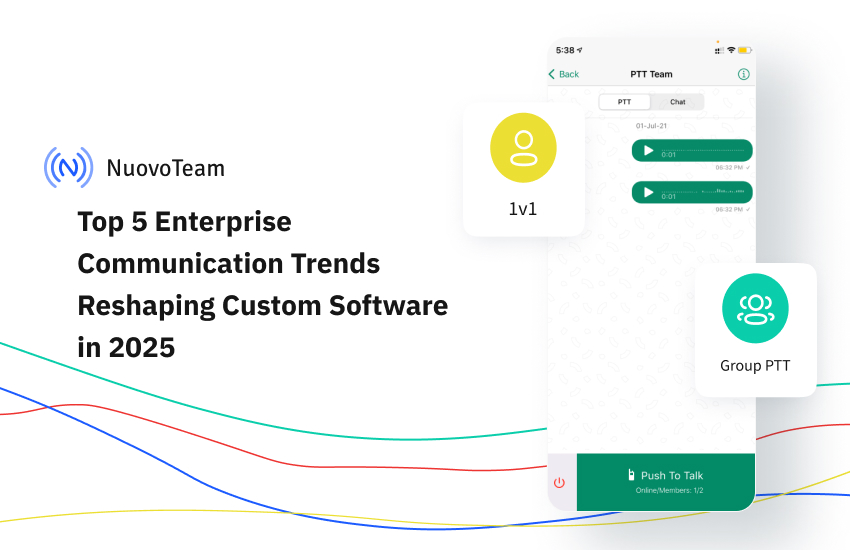Communication at work has changed. Again. And if it feels like it’s changing faster than your team can keep up with, you’re not alone.
In 2025, the way we talk, share, and collaborate at work is no longer about just being connected—it’s about being effective. And that shift is putting pressure on how custom software is built. It’s not just about features anymore. It’s about how people use them together.
More IT services companies are rethinking communication as a core part of their custom software offerings—not just a layer, but the framework itself.
Here are five communication trends quietly reshaping the way custom software development companies gets designed, built, and adopted in the enterprise world.
1. Teams Expect Tools That Speak Their Language
Not literally—but close. Teams today don’t want generic messaging tools that treat everyone the same. A marketing team and a product engineering team don’t operate the same way, so why should their communication tools?
This shift is driving demand for custom platforms that adapt—to roles, routines, and even preferences. This encourages many to explore how to create an app like Slack for better collaboration and flexibility. In the realm of market-making software development, interfaces that feel cluttered to one team might be just right for another. Custom software is being built to flex, not force.
Bottom line? Smart personalization isn’t just a nice touch—it’s becoming table stakes.
2. AI Isn’t Just Helping, It’s Filtering the Noise
You’ve probably seen it already. Meeting notes showing up without anyone typing them. Chat threads summarized before you even scroll. You can explore how AI-driven tools enhance long-term planning too—check out our ai retirement calculator for dynamic forecasting that complements this AI-powered efficiency. That’s AI—quietly becoming the teammate who never misses a detail. From drafting emails to creating AI-generated videos for marketing, it’s becoming part of everyday workflows.
It’s not about artificial intelligence (AI) for its own sake. It’s about solving a real problem: information overload. The kind that slows down decisions and buries what’s important.
Custom platforms in 2025 are being built with baked-in intelligence—from conversational AI chatbots that answer queries in real time to systems that pull out what matters and ignore what doesn’t. And when done well, it just feels… effortless.
3. Communication Isn’t a Separate Tab Anymore
The days of “Do the work here, then talk about it there” are fading. The modern workflow doesn’t have time for that kind of app-switching.
In the best custom software today, communication is built into the workflow—not stacked on top of it. Think: commenting directly on a line of code, logging an issue via voice while in the field, or approving a budget within a chat window. Alternatives to Vibe coding tools are also aligning with this trend, blending development and communication in a single seamless environment.
This isn’t just efficient—it’s frictionless. And it’s becoming the new normal.
4. Security Is No Longer Invisible and That’s a Good Thing
Between tightening privacy laws and rising cyber threats, communication tools can’t afford to be casual about data anymore.
Encrypted messages. Controlled file sharing. Logged conversations. What once lived quietly in the background is now a visible part of the user experience—especially for industries where compliance isn’t optional.
Developers building for 2025 are taking note. Security is no longer something you bolt on. It’s part of how the product communicates trust from the first interaction.
5. Voice Is Back (and Not Just in Meeting Rooms)
Push-to-Talk features aren’t new. But their return is surprising—and smart.
In logistics, retail, manufacturing, and field service roles, there’s no time to tap out messages. Teams are turning back to voice, but with modern upgrades: offline support, auto-transcription, even voice recognition tied to secure identities.
For developers, this means rethinking UX for moments when hands are full or screens aren’t practical. And it’s bringing voice-first design back into serious consideration.
Communication Is Becoming the Framework—Not Just a Feature
It’s easy to think of communication tools as chat boxes or call buttons. But for enterprises in 2025, communication has become the backbone of productivity—and custom software is adapting to reflect that.
The smartest platforms today don’t just support communication. They are the communication.If you’re building or evaluating custom tools this year, the question isn’t just “Does it work?”
It’s “Does it connect the people using it—in ways that actually make sense?”
